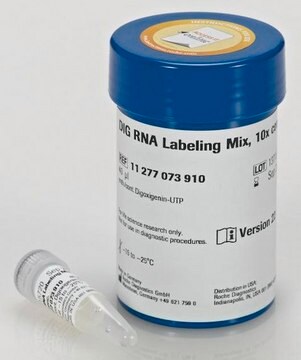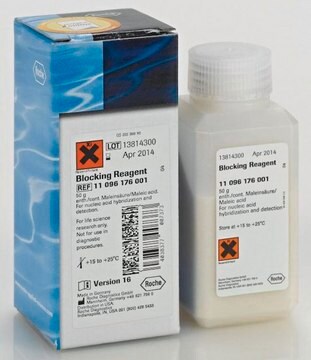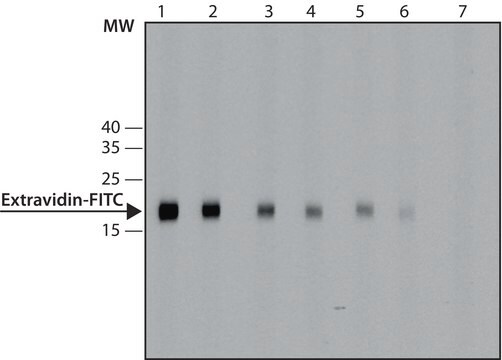11426346910
Roche
Anti-Fluorescein-POD, Fab fragments
from sheep
Synonym(s):
antibody
Sign Into View Organizational & Contract Pricing
All Photos(1)
About This Item
UNSPSC Code:
12352203
Recommended Products
biological source
sheep
Quality Level
conjugate
peroxidase conjugate
antibody form
purified immunoglobulin
antibody product type
primary antibodies
clone
polyclonal
form
lyophilized (stabilized)
packaging
pkg of 150 U
manufacturer/tradename
Roche
storage temp.
2-8°C
General description
Fab fragments from polyclonal anti-fluorescein antibodies, conjugated to horseradish peroxidase. The reagent is an anti-fluorescein antibody, Fab fragments from sheep, conjugated with horse-radishperoxidase (POD). After immunization with fluorescein the sheep IgG (immunoglobulin G) was purified by ion exchange chromatography and the specific IgG was isolated by immunosorption. The Fab fragments obtained by papain digestion were purified by gel filtration, conjugated with POD and stabilized in 60mM Tris-Hepes-buffer, 0.4% bovine immunoglobulin (w/v), 0.2% Germall II (w/v), pH 7.2.
Specificity
The polyclonal antibody reacts with free and bound fluorescein.
Application
Anti-Fluorescein-POD, Fab fragments are used for detection of fluorescein-labeled compounds in:
- Dot blot
- ELISA (enzyme-linked immunosorbent assay)
- Immunohistocytochemistry
- In situ hybridization
- Southern blot
- Western blot
Preparation Note
Working concentration: Working concentration of conjugate depends on application and substrate. The following concentrations should be taken as a guideline:
Working solution: 100 mM Tris-HCl, 150 mM NaCl, pH 7.5. If necessary 1% Blocking reagent (w/v), dry milk powder, 1 to 5% heat inactivated fetal calf serum (v/v) or sheep normal serum can be used for reduction of unspecific binding.
- Dot blot: 150 mU/ml
- ELISA: 50 to 150 mU/ml
- Immunohistocytochemistry: 250 to 500 mU/ml
- In situ hybridization: 1.5 to 7.5 U/ml
- Southern blot: 150 mU/ml
- Western blot: 500 to 1000 mU/ml
Working solution: 100 mM Tris-HCl, 150 mM NaCl, pH 7.5. If necessary 1% Blocking reagent (w/v), dry milk powder, 1 to 5% heat inactivated fetal calf serum (v/v) or sheep normal serum can be used for reduction of unspecific binding.
Reconstitution
Add 1 ml double-distilled water to a final concentration of 150 U/ml.
Other Notes
For life science research only. Not for use in diagnostic procedures.
Not finding the right product?
Try our Product Selector Tool.
Signal Word
Warning
Hazard Statements
Precautionary Statements
Hazard Classifications
Skin Sens. 1
Storage Class Code
12 - Non Combustible Liquids
WGK
WGK 1
Flash Point(F)
does not flash
Flash Point(C)
does not flash
Certificates of Analysis (COA)
Search for Certificates of Analysis (COA) by entering the products Lot/Batch Number. Lot and Batch Numbers can be found on a product’s label following the words ‘Lot’ or ‘Batch’.
Already Own This Product?
Find documentation for the products that you have recently purchased in the Document Library.
Customers Also Viewed
Nicolle A Bonar et al.
Development (Cambridge, England), 144(5), 784-794 (2017-01-28)
Animals capable of adult regeneration require specific signaling to control injury-induced cell proliferation, specification and patterning, but comparatively little is known about how the regeneration blastema assembles differentiating cells into well-structured functional tissues. Using the planarian Schmidtea mediterranea as a
Chen Wang et al.
Cell discovery, 2, 16029-16029 (2016-08-24)
Pigmentation processes occur from invertebrates to mammals. Owing to the complexity of the pigmentary system, in vivo animal models for pigmentation study are limited. Planarians are capable of regenerating any missing part including the dark-brown pigments, providing a promising model
Kunio Kondoh et al.
Nature, 532(7597), 103-106 (2016-03-24)
Instinctive reactions to danger are critical to the perpetuation of species and are observed throughout the animal kingdom. The scent of predators induces an instinctive fear response in mice that includes behavioural changes, as well as a surge in blood
Jingwen Liu et al.
PLoS biology, 17(8), e3000203-e3000203 (2019-08-21)
Zebrafish dorsal forerunner cells (DFCs) undergo vigorous proliferation during epiboly and then exit the cell cycle to generate Kupffer's vesicle (KV), a ciliated organ necessary for establishing left-right (L-R) asymmetry. DFC proliferation defects are often accompanied by impaired cilia elongation
Elena Grassi et al.
Frontiers in cellular neuroscience, 12, 518-518 (2019-01-29)
Alternative polyadenylation (APA) is a widespread mechanism involving about half of the expressed genes, resulting in varying lengths of the 3' untranslated region (3'UTR). Variations in length and sequence of the 3'UTR may underlie changes of post-transcriptional processing, localization, miRNA
Our team of scientists has experience in all areas of research including Life Science, Material Science, Chemical Synthesis, Chromatography, Analytical and many others.
Contact Technical Service







